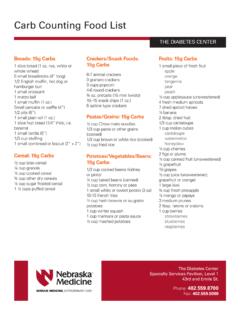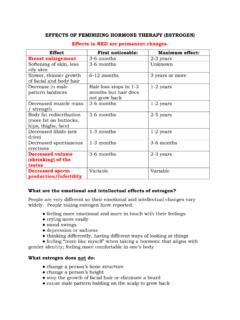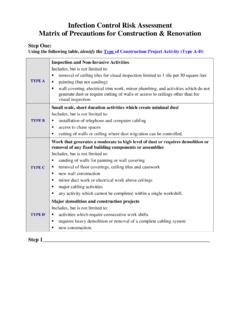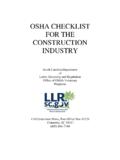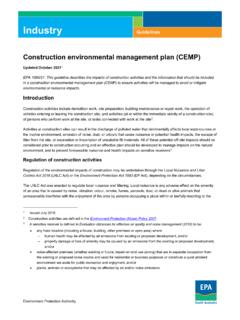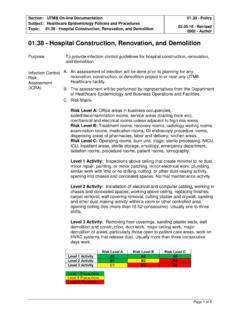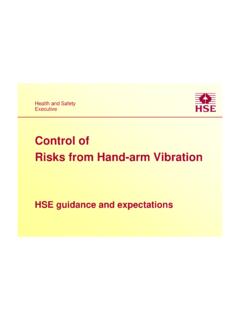Transcription of Infection Control Risk Assessment (ICRA) during Construction
1 Infection Control Risk Assessment (ICRA) during Construction and Renovation1 This matrix is to be used to set guidelines on the appropriate Infection prevention and Control procedures required for the type of activity depending on where the activity will occur. The Infection Prevention and Control representative may add or omit requirements specific to a project. Recommended barriers are to be installed before Construction begins. Step 1: Identify the Type of Construction Activity Planned: Type A Inspection and Non-invasive activities. Includes but is not limited to removal of ceiling tiles for visual inspection (limited to 1 tile per 50 square feet), painting, wall covering, electrical trim work, minor plumbing and activities that do not generate dust or require cutting of walls.
2 Type B Small scale, short duration activities that create minimal dust . Includes but is not limited to installation of telephone and computer cables, access to chase spaces, cutting of walls or ceiling where dust migration can be easily controlled at the source. Type C Any work that generates a moderate to high level of dust or requires demolition or removal of any fixed building components or assemblies. Includes but is not limited to sanding walls, for painting or wall coverings, removing floor coverings, ceiling tiles and millwork, new wall Construction , minor ductwork or electrical work above ceilings, major cabling activities and any activity that cannot be completed within a single work shift within the set containment.
3 Type D Major demolition and Construction projects Includes but is not limited to activities that require consecutive work shifts, heavy demolition or removal of a complete ceiling system and new Construction . 1 Matrix modified from Bartley J. Infection Control Issues in Construction and Renovation Toolkit. Association for Professionals in Infection Control and Epidemiology, Inc. 2007; 89-91. Step 2: Determine Risk Group Impacted by the Proposed Construction Activity: Lowest Risk Medium Risk High Risk Highest Risk 1. Office areas 2. Engineering 3. Environmental Services 1. All patient care units not listed in Groups 3 or 4.
4 2. Rehabilitation 3. Cardiac rehab 4. Radiology/MRI 5. Outpatient Services 6. Cafeteria- non- food prep area 1. Emergency 2. Post-anesthesia Recovery Units 3. Labor & Delivery 4. Newborn Nurseries 5. Nuclear medicine 6. Echocardiography 7. Central Supply 8. Pediatrics, inpatient 9. Laboratory 10. Endoscopy 11. Cafeteria food prep area 12. Anesthesia work rooms 1. Operating rooms, including C-section 2. Cardiac Catheterization 3. Intensive Care Units 4. Oncology 5. Infusion/Radiation Therapy 6. Pharmacy admixture 7. Dialysis, inpatient 8. Sterile Processing 9. Any area caring for immunocompromised patients Step 3: Assign a Class Based on Prior Assessments: Risk Level Construction Activity Type A Type B Type C Type D Lowest Risk Class 1 Class 2 Class 2 Class 3/4 Medium Risk Class 1 Class 2 Class 3 Class 4 High Risk Class 1 Class 2 Class 3/4 Class 4 Highest Risk Class 2 Class 3/4 Class 3/4 Class 4 Step 4: Identify any areas surrounding the project area, assessing the potential Impact: Dept.
5 Above Dept. Below Lateral Lateral Behind Front Risk Group Risk Group Risk Group Risk Group Risk Group Risk Group Step 5: Review traffic flow and debris Control (how and when), Are hand washing sinks going to be blocked or shut off. Is an ILSM needed? Yes No Step 6: Execute Requirements for Construction Procedures Based on Classification Assignment. Copy the form on the next two pages and complete. Completed forms should be forwarded to Infection Prevention and Control and Planning and Construction or Facilities Management Project Managers for department files. Infection Control Construction Permit Project Name: Project Number: MOP Number: eMac Number: Project Manager: Project Start Date: Location of Construction : Estimated Duration: Contractor Performing Work: Permit Expiration Date: Construction Supervisor: Telephone: YES NO Construction ACTIVITY YES NO Infection Control RISK GROUP TYPE A: Inspection, non-invasive activity GROUP : Least Risk TYPE B: Small scale, short duration, moderate to high levels GROUP : Medium Risk TYPE C: Activity generates moderate to high levels of dust , requires greater than 1 work shift for completion GROUP : High Risk TYPE D.
6 Major duration and Construction activities requiring consecutive work shifts GROUP : Highest Risk CLASS 1 Date: _____ Initial: _____ A. Minimize raising dust from Construction operations. B. Doors within the travel path of Construction activity shall be kept closed. C. Immediately replace any ceiling tile displaced during visual inspection. D. Immediately clean any dust that may have been created from all surfaces. E. Areas suspected of water damage, past or present should be sprayed with copper 8-quinolinolate or equivalent and Infection Prevention notified. F. Building Materials will remain dry and will be discarded if cannot be completely dried in 48 hours. CLASS 2 Date: _____ Initial: _____ A.
7 Provide active means of preventing airborne dust from dispersing into atmosphere. B. Seal un-used doors with duct tape or Long Mask tape. C. Block off and seal air vents. D. Remove or isolate HVAC system in areas where work is being performed. E. Outside exhaust locations must be 30 feet from air intake locations unless otherwise noted. F. Lightly mist debris and contain Construction waste before transport in tightly covered containers. Debris should be removed daily. Do not board elevators containing patients when removing. G. Water-mist work surfaces to Control dust while cutting. H. Wet mop and/or vacuum with HEPA filtered vacuum before leaving area. I. Wipe all surfaces with hospital-approved disinfectant.
8 J. Place adhesive mat at entrance and exit of work area. Adhesive mats should be type to remove dust and debris from footwear exiting the Construction zone. K. All items in previous class (es) must also be performed. CLASS 3 Date: _____ Initial: _____ A. Obtain Infection Control approval before Construction begins. B. All items in previous class (es) must also be performed. C. Construct physical barrier with anteroom if possible before Construction begins. D. Seal holes, pipes, conduits and punctures appropriately. E. Maintain negative air pressure @ minimum .03 inches water gauge within work site using HEPA-filtered air filtration units. F. Attach 24/7 auto dialer monitoring to system and provide emergency power.
9 G. Personnel clothing leaving work site should be free of loose soil and debris. (2) 2'x4' adhesive mats should also be used. H. Tools and carts are to be damp wiped before leaving the Construction area. I. Vacuum work area with HEPA-filtered vacuums daily. Filters are to be sealed in bags for site removal. J. Lightly mist debris and contain Construction waste in tightly covered containers. Debris should be removed daily, or more frequently, if necessary. Do not board elevators containing patients when removing wastes. K. Cover transport receptacles or carts. L. Wet mop or wipe down area immediately adjacent to the Construction area and just inside, with owner-approved disinfectant daily.
10 M. Do not remove Construction barriers until project is thoroughly cleaned by Environmental Services. N. Clean air ducts and filters in Construction area prior to removing Construction barrier. O. Barriers will be cleaned before removal and upon completion of the project with the approval of the Facilities Management Project Manager. P. Remove barriers carefully to minimize spreading dirt and debris. CLASS 4 Date: _____ Initial: _____ A. Obtain Infection Control approval before Construction begins. B. All items in previous class (es) must also be performed. C. Construct anteroom and require personnel to pass through this room so they can be vacuumed using a HEPA-filtered vacuum before leaving work site or wear cloth or paper coveralls that are removed each time they leave the work site.




